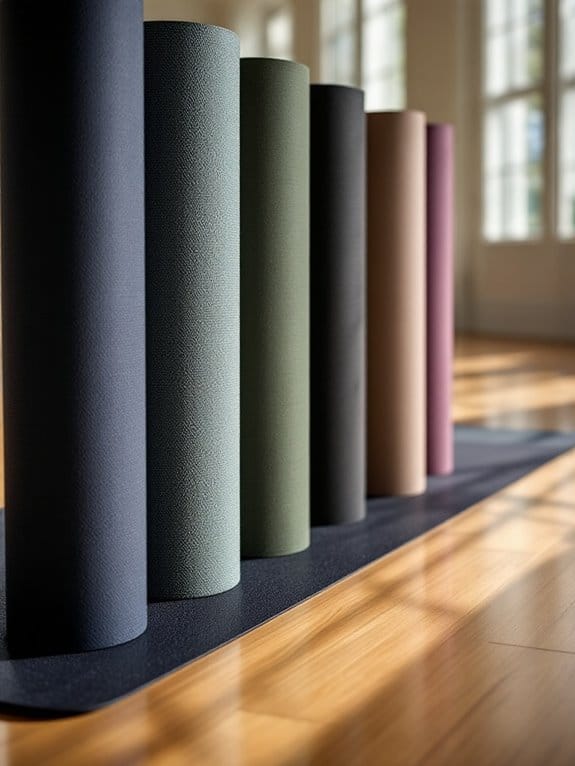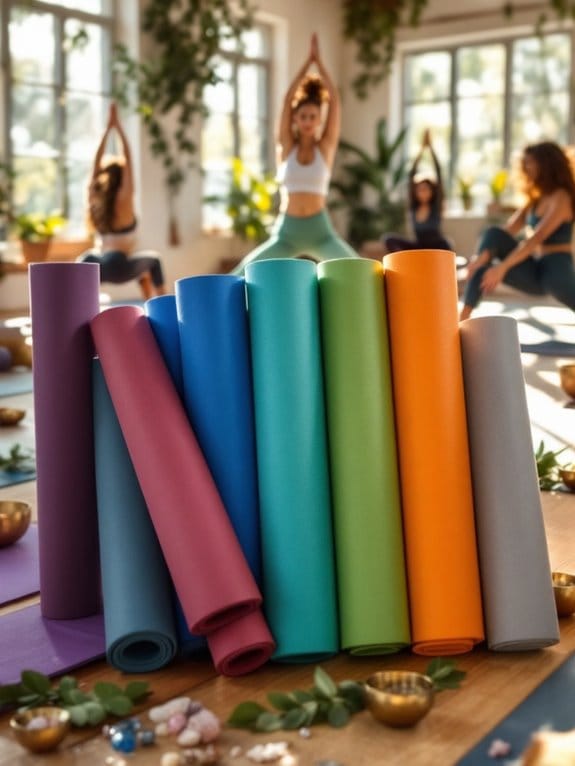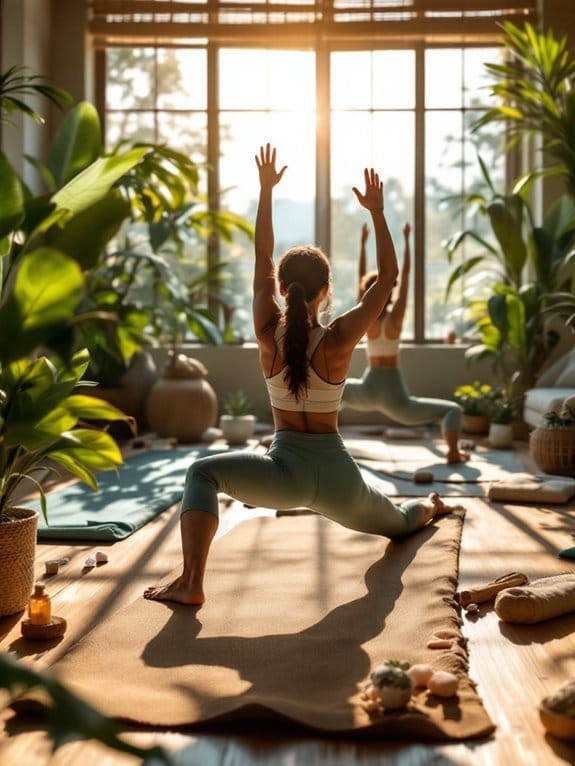For 2025, Manduka's top yoga mats showcase diverse features to match your practice style. The GRP Adapt excels in hot yoga with its moisture-wicking technology, while the eKO Lite offers eco-friendly durability at 4mm thick. The PRO mat's 6mm cushioning provides maximum joint support, and the lightweight eKO Superlite proves perfect for travel. Each mat's unique characteristics, from grip technology to thickness options, help you find your ideal match. Let's explore what makes each mat stand out.
Key Takeaways
- Manduka PRO Yoga Mat (6mm) leads the lineup with its ultra-dense cushioning and exceptional 15+ year lifespan for dedicated practitioners.
- The GRP Adapt Hot Yoga Mat excels with its innovative Moisture Flow technology and dual-layer grip system for intense sessions.
- The eKO Lite 4mm offers an eco-friendly choice with natural tree rubber construction and optimal balance between cushioning and stability.
- For travelers, the eKO Superlite provides unmatched portability at 2.2 pounds while maintaining professional-grade performance and durability.
- Each Manduka mat excels in specific practices: PRO for general yoga, GRP for hot yoga, eKO for eco-conscious practitioners.
Manduka GRP Adapt Hot Yoga Mat (Non-Slip & Sweat Resistant)
- ULTIMATE GRIP: GRP Adapt delivers Manduka’s best grip yet with a Satin Grip top layer that performs in any condition—no towel needed, no slipping, just pure traction
- VERSATILE FOR ALL STYLES: Designed for any flow, from slow yin to intense hot yoga. Seamless transitions and stability make it the go-to mat for every type of practice
- SWEAT ABSORPTION: Moisture Flow scrim absorbs 2x more sweat than competitors, drawing moisture into the mat for a dry, slip-free surface every time
The Manduka GRP Adapt Hot Yoga Mat stands out as the ultimate choice for yogis who sweat heavily during their practice. You'll find reliable stability with its Satin Grip top layer and Versa Grip bottom layer, making pose changes seamless.
At 71 inches long and 26 inches wide, you've got ample space to move. The mat's Moisture Flow cellular scrim absorbs sweat, so you won't need a separate towel. Its 5mm thickness delivers joint support through Responsive Ride technology, while the durable rubber construction maintains its shape over time.
Though it's a bit heavy at 5 pounds, you'll appreciate the mat's consistency during intense sessions.
Best For: Dedicated hot yoga practitioners and heavy sweaters seeking a premium, grip-secure mat that eliminates the need for additional towels during intense sessions.
Pros:
- Exceptional sweat absorption and moisture management through specialized Moisture Flow technology
- Superior non-slip performance with dual-layer grip system for stable poses
- Durable construction with excellent cushioning for joint protection
Cons:
- Relatively heavy at 5 pounds, making it less portable
- Higher price point compared to standard yoga mats
- May require initial airing out period to eliminate rubber odor
MANDUKA EKO Lite Yoga Mat 4mm
- LIGHTWEIGHT & EARTH-FRIENDLY: Made from biodegradable, 100% natural tree rubber and non-toxic materials, the eKO Lite mat features a soft, textured surface and a lighter,...
- TEXTURED GRIP FOR CONTROL: The eKO mat’s unique surface texture enhances grip and stability, giving you grounded support across styles—ideal for strong flows or slow,...
- PREMIUM MATERIALS: 4mm thickness with a Rippled Catch-Grip Design. 99% latex-free, closed-cell design prevents moisture and buildup for a clean practice, making our mats...
Eco-conscious yogis will find their perfect match in Manduka's eKO Lite 4mm mat. This biodegradable mat's made from natural tree rubber, offering twice the durability of other rubber mats while staying 99% latex-free.
You'll notice an initial rubber smell that dissipates over time. At 71 x 24 inches and 5 pounds, it's both spacious and portable. The closed-cell surface prevents sweat absorption, while the non-slip grip keeps you stable during challenging poses.
When it comes to maintenance, you'll only need a damp cloth. The mat's zero-waste manufacturing process and superior joint protection make it worth the investment, despite occasional user reports of peeling.
Best For: Environmentally conscious yoga practitioners who want a durable, high-performance mat with excellent grip and are willing to invest in quality.
Pros:
- Exceptional durability and grip performance, lasting twice as long as typical natural rubber mats
- Eco-friendly manufacturing process with biodegradable materials and zero waste
- Closed-cell surface prevents sweat absorption while providing good cushioning for joints
Cons:
- Strong initial rubber odor that requires time to dissipate
- Higher price point compared to basic yoga mats
- Some users report issues with peeling over time with intense use
Manduka PRO Yoga Mat (6mm Ultra-Dense)
Professional yogis and dedicated practitioners will find their perfect match in Manduka's PRO Yoga Mat, featuring an ultra-dense 6mm cushioning system. You'll appreciate its grippy textured surface that prevents slipping during challenging poses and hot yoga sessions.
The mat's impressive 85-inch length guarantees you won't run out of space during practice. While it's heavier at 3.4 kg, you're getting unmatched durability that can last 15+ years. To maintain ideal grip, you can use a green abrasive pad with a gentle cleanser, though this isn't warranty-approved.
Watch for authenticity when purchasing – genuine PRO mats weigh about 4.3 kg and measure exactly 6mm thick. You're investing in what many consider the gold standard of yoga mats.
Best For: Serious yoga practitioners, professional instructors, and dedicated students seeking a premium, long-lasting mat with superior grip and cushioning for daily practice.
Pros:
- Exceptional durability with reported lifespans of 15+ years of regular use
- Superior grip and stability with textured surface ideal for hot yoga and challenging poses
- Extra-long 85-inch length provides ample space for all types of movements and positions
Cons:
- Heavy weight (3.4 kg) makes it less portable for commuting
- Higher price point compared to standard yoga mats
- May require special cleaning methods to maintain optimal grip, which could void warranty
Gaiam Dry-Grip Non-Slip Yoga Mat (5mm Thick)
- Thick Yoga Mat - The Gaiam 5 mm thick dry-grip yoga mats are durable everyday exercise mats that help provide additional cushioning for your joints during any yoga or...
- Non-Slip Grip - This yoga mat has a stay-dry topcoat to provide excellent traction and superior grip so you can stay focused on holding yoga poses for extended periods of...
- Great for Hot Yoga - The textured, coated surface is made for working up a sweat during hot yoga sessions and holds up well in that environment. Theses hot yoga mat have...
Anyone seeking superior grip during sweaty yoga sessions will find their match in Gaiam's Dry-Grip Non-Slip Mat. At 5mm thick, it provides firm cushioning that'll protect your joints during challenging poses like downward dog.
You'll appreciate the stay-dry topcoat that wicks away moisture and maintains traction even during hot yoga. The 68 x 24-inch dimensions give you plenty of space to flow, while the PVC construction guarantees durability without latex or rubber.
Just keep in mind it's a bit bulky for carrying around, and you'll need to air it out initially to eliminate the new-mat smell. But with proper care using mild soap or vinegar solutions, it'll serve your practice for years.
Best For: Yoga practitioners who need superior grip and cushioning during hot yoga or intense sessions where sweating is common.
Pros:
- Excellent non-slip surface that maintains grip even during sweaty practices
- Thick 5mm cushioning provides robust joint protection
- Durable construction that lasts for years with proper maintenance
Cons:
- Heavier and bulkier than standard mats, making it less portable
- Initial rubber odor requires airing out before first use
- Not reversible and can show scuff marks from shipping
Manduka eKO Superlite Yoga Travel Mat
- EKO SUPERLITE TRAVEL MAT: The eKO SuperLite is perfect for yogis on the go. Its foldable, travel-ready design offers portability without sacrificing support or stability,...
- ON-THE-GO FITNESS: Ideal for eco-conscious travel yogis, the 1.5mm thickness, textured grip, and foldable design make it easy to pack and carry—while still offering...
- PREMIUM MATERIALS: Made from sustainably harvested, all- natural tree rubber, this mat features a closed-cell surface that locks out moisture. It’s 99% latex-free and...
Traveling yogis seeking a lightweight companion will find their perfect match in the Manduka eKO Superlite Travel Mat. At just 2.2 pounds and 1.5mm thick, you'll barely notice it in your bag. The mat's 71 x 24-inch dimensions provide ample space for your practice.
You'll appreciate the eco-friendly construction from biodegradable tree rubber, which delivers excellent grip without harming the planet. The closed-cell surface prevents sweat absorption, while the tightly woven scrim resists tearing. When you're ready to move, simply roll or fold it – the mat maintains its shape without creasing. For sensitive joints, you might want to add a towel for extra cushioning during longer sessions.
Best For: Frequent travelers and mobile yogis who prioritize portability and eco-friendliness in their yoga practice.
Pros:
- Extremely lightweight and portable, easily folds or rolls for travel
- Made from sustainable, biodegradable natural tree rubber with excellent grip
- Durable construction with tear-resistant scrim and closed-cell surface that prevents sweat absorption
Cons:
- Very thin (1.5mm) which may be uncomfortable for some practitioners
- May require additional padding for sensitive joints during longer sessions
- Can become slippery during intense, sweaty practices
Factors to Consider When Choosing a Maduka Yoga Mat

When you're ready to invest in a Manduka yoga mat, you'll need to weigh several key factors that affect your practice. You'll want to evaluate the mat's thickness (ranging from 1.5mm to 6mm), grip quality, and whether it's made from eco-friendly or traditional PVC materials. The right choice depends on your specific yoga style, available storage space, and whether you'll need to carry your mat frequently.
Mat Thickness and Support
The three most essential aspects of yoga mat thickness directly impact your practice comfort and performance. When you're choosing a Manduka mat, you'll need to evaluate how thickness affects your joint support, stability, and portability.
If you've got sensitive joints, you'll appreciate a 6mm mat's generous cushioning for knee-heavy poses. A 4mm thickness offers you that sweet spot between comfort and stability, making it ideal for most practice styles. You'll find it's thick enough to protect your joints while keeping you connected to the ground.
For travelers or minimalists, a 1.5mm mat might be your best choice. While you'll sacrifice some cushioning, you'll gain excellent portability and enhanced ground feel. Remember, there's no universal "best" thickness – it's about matching the mat to your specific needs and preferences.
Grip and Slip Resistance
Since your safety and performance rely heavily on reliable traction, grip becomes a make-or-break feature in any Manduka mat. You'll want to focus on textured surfaces that prevent slipping, especially during challenging poses or sweaty sessions.
When evaluating Manduka's grip options, pay attention to their rubber-based models, which typically offer superior traction compared to synthetic alternatives. For hot yoga enthusiasts, you'll benefit from Manduka's moisture-wicking technology that maintains grip even when you're dripping with sweat.
Remember that thicker mats might feel more cushioned, but they can sometimes compromise your stability. To maintain your mat's grip performance, you'll need to clean it regularly. Manduka's natural rubber surfaces respond well to gentle cleaning solutions, preventing the buildup of sweat and dirt that could make your practice less secure.
Material and Durability
Materials form the cornerstone of your yoga mat's long-term performance and sustainability. When you're investing in a Manduka mat, you'll want to focus on closed-cell surfaces that resist sweat absorption and maintain their grip over time.
Natural rubber options, particularly those made from 100% tree rubber, will serve you better than synthetic alternatives. You'll notice these mats don't break down as quickly, even with regular use. For maximum durability, look for mats that are at least 6mm thick – they'll protect your joints while withstanding intense practice sessions.
To extend your mat's lifespan, stick to gentle cleaning methods. Hand wash your mat with mild soap, and avoid harsh chemicals that can degrade the surface. With proper care, a high-quality Manduka mat made from eco-friendly materials can last considerably longer than standard options.
Intended Practice Style
Selecting your perfect Manduka mat starts with understanding your preferred yoga style and practice intensity. If you're into hot yoga, you'll want a mat with advanced moisture control to maintain grip when you're sweating.
For vinyasa or power yoga practitioners, prioritize mats with superior non-slip surfaces to keep you stable during quick shifts. You'll benefit from a thinner mat (around 4-5mm) that allows better balance and ground connection. If you practice gentle or restorative yoga, consider a thicker mat (6mm or more) for extra joint cushioning.
Remember to match your mat's durability to your practice frequency. Daily practitioners should invest in Manduka's PRO series, which withstands intense use. For occasional practice, the lighter eKO series offers a balance of performance and eco-friendly materials.
Weight and Portability
Weight and portability rank among the key factors that'll shape your daily yoga experience. When choosing a Manduka mat, you'll need to balance stability against ease of transport.
If you're commuting to classes or traveling frequently, consider a lighter mat around 2.2 lbs. These mats roll up easily and won't weigh down your yoga bag. For home practice, you might prefer a heavier mat (5+ lbs) that offers superior cushioning and stays put during dynamic movements.
Pay attention to thickness measurements: thinner mats (1.5-5mm) typically weigh less than thicker options (6mm+). While natural rubber mats provide excellent grip, they're often heavier than synthetic alternatives. You'll want a mat that maintains its shape without creasing when rolled, especially if you're storing it between sessions or packing it in luggage.
Environmental Impact
When it comes to sustainable yoga practice, your mat choice can have a lasting impact on the environment. Manduka's commitment to eco-friendly materials, like natural rubber, helps reduce your carbon footprint while you practice.
You'll find that Manduka's zero-waste manufacturing process repurposes every scrap, keeping unnecessary waste out of landfills. Their chemical-free construction eliminates PVC and toxic plasticizers, which means you're breathing cleaner air during your flows.
While premium Manduka mats might cost more upfront, they're built to last considerably longer than budget alternatives. You won't need to replace them as often, which means fewer mats end up in landfills. By choosing a Manduka mat, you're joining a community that values environmental responsibility. These mats support both your practice and the planet's wellbeing.
Price Vs Quality
Understanding the balance between price and quality remains essential in choosing your ideal Manduka mat.
When you're comparing costs, you'll want to evaluate the long-term value rather than just the initial price tag. High-quality Manduka mats can last up to 15 years, while cheaper alternatives might need replacement within months. You'll find that premium materials, like natural rubber, offer superior grip and moisture management for hot yoga sessions.
While you might hesitate at higher upfront costs, investing in a quality Manduka mat often proves more economical over time. You're not just paying for durability – you're investing in enhanced performance and comfort. Reflect on this: replacing a budget mat yearly at $30 adds up to $450 over 15 years, while a $150 premium mat could serve you throughout that period.
Frequently Asked Questions
How Long Does a Manduka Yoga Mat Typically Last With Regular Use?
With proper care, you'll get 8-10 years from a Manduka PRO mat during regular practice (3-4 times weekly). You'll notice these mats don't wear down like cheaper alternatives – they're built to last. If you're practicing daily or teaching multiple classes, expect 5-7 years of reliable use. The key is wiping down your mat after each session and deep cleaning it monthly. You'll know it's time to replace when grip noticeably decreases.
Can Manduka Yoga Mats Be Used Outdoors on Rough Surfaces?
While you can use Manduka mats outdoors, it's not ideal for rough surfaces. The mat's premium materials can get damaged by rocks, twigs, and abrasive terrain. If you're practicing outside, try placing your Manduka on a smooth deck or patio instead. For rough ground, consider using an inexpensive mat or outdoor-specific yoga blanket. You'll protect your investment and still enjoy your practice in nature.
What's the Best Way to Clean and Maintain Manduka Mats?
After a sweaty hot yoga session, you'll want to clean your Manduka mat properly. Here's how: Mix equal parts water and white vinegar in a spray bottle. Spritz lightly, then wipe with a non-abrasive cloth. For deep cleaning, use Manduka's mat wash or gentle soap. Let it air dry completely before rolling. Don't use harsh chemicals or soak the mat. Regular maintenance includes wiping after each use and storing unrolled when possible.
Are Manduka Yoga Mats Worth Their Higher Price Point?
Yes, Manduka mats are worth the investment if you practice yoga regularly. You'll benefit from their exceptional durability – they often last 10+ years with proper care. While you'll pay $100-$150 upfront, that's only about $10-15 per year. Their dense cushioning and grip improve with use, unlike cheaper mats that deteriorate quickly. You're also getting eco-friendly materials and a lifetime guarantee, making them a smart long-term investment.
Do Manduka Mats Contain Latex or Other Common Allergens?
You'll be glad to know that Manduka yoga mats are latex-free and don't contain most common allergens. Their PRO and PROlite series use eco-certified PVC that's 100% latex-free. If you have sensitivities, you'll want to check their eKO series, which contains natural tree rubber – a potential allergen for some people. For complete peace of mind, you can easily find detailed material specs on Manduka's website or product packaging.










